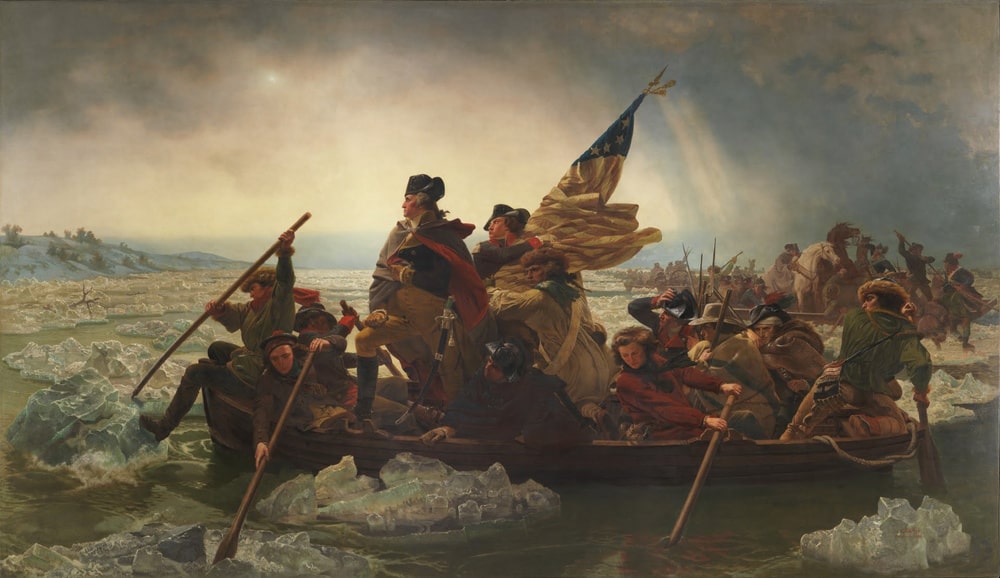Contents
Contents

With the possible exceptions of DaVinci’s Mona Lisa and the Last Supper, this is perhaps the most universally recognized image in the entire history of art.
It is also an image that historians love to hate.
Painted in Dusseldorf, Germany around 1851, the artist had lived in America as a boy, and after going back to Germany, had returned to America many times (years later he would emigrate here). While in the United States, he visited the Smithsonian and examined Washington’s uniform and sword, and carefully studied paintings and sculptures of the Great General which were done in Washington’s lifetime. Yet, despite this intensive research into historical accuracies, Leutze then let his artistic license run wild. Perhaps that is why this painting is usually classified in the “Romantic” school of art.
The actual crossing was done in the dead of night, during a driving snowstorm, and was completed by three a.m. Leutze indulged in symbolism showing Washington leading his men out of a stormy darkness into a new dawn of freedom. Indeed, although you can’t make it out in our electronic image, in the original, in the sky directly above the foremost oarsman, Leutze painted in the morning star, invoking the legend of the wise ones following the star at Christmas.
Two future Presidents of the United States crossed the river that fateful night, James Madison and James Monroe. Also along with the army were a future Chief Justice of the United States Supreme Court, John Marshall, and famous rivals Aaron Burr and Alexander Hamilton.
Besides Washington, only two of the figures in the boat have been identified. Look closely at the fellow holding the flag, and you’ll see James Monroe. He was quartered in the house where Washington made the decision to cross, and served as a scout and trusted adviser to the General, but there’s nothing in the historical records to indicate he crossed in the same boat. Note the so-called “Betsy Ross” flag, with the stars in a circle. This design first came into existence some six months after the crossing.
The other recognizable figure, pulling on an oar at Washington’s knee, is Prince Whipple, a black patriot who has become a minor legend of the Revolution. As an early biographer said of him: “Prince Whipple was born in Amabou, Africa, of comparatively wealthy parents. When about ten years of age, he was sent by them, in company with a cousin, to America to be educated. An elder brother had returned four years before, and his parents were anxious that their child should receive the same benefits. The captain who brought the two boys over proved a treacherous villain, and carried them to Baltimore, where he exposed them for sale, and they were both purchased by Portsmouth men, Prince falling to Gen. Whipple. He was emancipated during the [Revolutionary] war, was much esteemed, and was once entrusted by the General with a large sum of money to carry from Salem to Portsmouth. He was attacked on the road, near Newburyport, by two ruffians; one was struck with a loaded whip, the other he shot… Prince was beloved by all who knew him. He was the “Caleb Quotom” of Portsmouth. where he died at the age of thirty-two leaving a widow and children.”
But, while many black soldiers served in Glovers Marblehead Regiment, the unit that ferried the army across the river, Prince Whipple wasn’t one of them. In fact, in December of 1776 he was in Baltimore.
Of course, few of the soldiers who crossed the river that horrible night to fight what was to be one of the few battles that can be said to have changed the course of the history of the entire world were as fortunate as Monroe or Madison. Major James Wilkinson, who was on his way to join Washington, found his route easy to follow: “There was a little snow on the ground, which was tinged here and there with blood from the feet of the men who wore broken shoes.” Primary documents differ about Patriot casualties, but even the most pessimistic reflect that the only American dead after the battle were two soldiers who froze to death.

